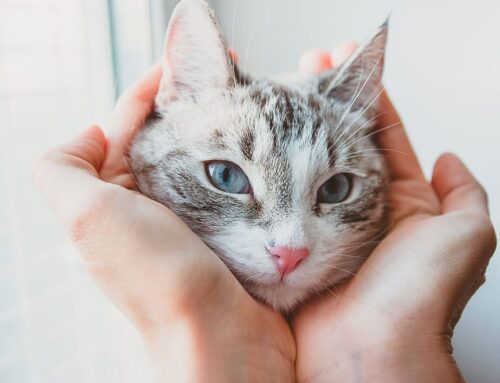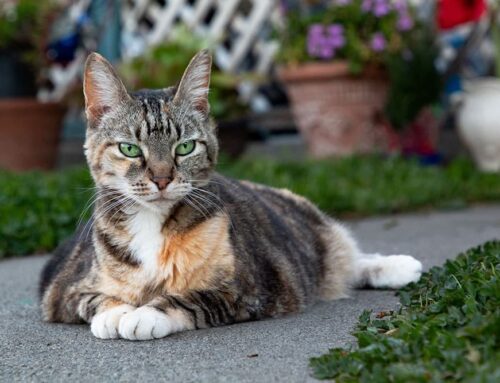Understanding Feline Idiopathic Cystitis (FIC)
With all of the changes in everyone’s household these days, some of our feline friends are having trouble adjusting to the new normal. From owners being at home instead of at work to the kids running around all day, our cats are having to adapt. While many cats are enjoying the adjustments to their daily routine, others struggle to deal with the stress of the environmental and household changes. In some cats this can lead to inappropriate urination around the house – certainly the last thing anyone wants to deal with right now! Anytime your cat is urinating outside of the litter box, contact your vet right away. There are numerous, some life threatening, causes of inappropriate elimination. In this blog, we’ll talk about one of the most common disorders called FIC – Feline Idiopathic Cystitis.
What is Feline Idiopathic Cystitis?
FIC is a syndrome describing when a cat is exhibiting a symptom of urinary discomfort and there are no physical concrete findings on diagnostic testing like stones. Symptoms can include straining to urinate, bloody urine, inappropriate elimination, urinary blockage (life threatening emergency), or licking at the urinary opening. A variety of issues in the bladder cause these symptoms so it’s important to contact your vet right away if you notice any one of them in your cat.
Unlike a tumor or bladder stones, FIC seems to be a psychological problem in response to stress in some cats. If the diagnostic work up of your affected cat comes up negative, FIC may be the culprit, especially in younger cats.
So how does a psychological problem manifest in the bladder?
The urinary bladder is lined with glycoproteins that insulate the tissue of the bladder from the urine itself. If the lining of the bladder becomes patchy then the bladder tissue is exposed to abrasive crystals and all the toxins and irritants the kidneys remove from the blood stream. This exposure results in inflammation. The lining becomes patchy when cats experience anxiety and stress.
How do we diagnose it?

Diagnostic testing will be necessary to rule out more concrete issues like blockages, stones, and tumors. Testing may include lab work (CBC and Chemistry), urinalysis,urine culture, x-ray, and/or ultrasound.
How do we treat FIC?
The best treatment for an active flare up of FIC is to manage the symptoms and make the cat more comfortable until the episode subsides. Medical management may include anti-spasmatics to help with urinary spasms and pain medication. FIC is very painful and proper pain control is crucial to recovery.
At any point, FIC, especially in male cats, can turn life threatening with a partial or full blockage. If you see your cat straining in the litterbox, seek emergency help immediately.
Why do some cats get FIC?
Cats that get FIC seem to be extra reactive to changes in their world and more prone to anxiety in general. Some common triggers for FIC include:
- Stress among the owner(s) or people in the household ranging from arguments, sickness, or stress/pressure
- Someone new to the family – person or new pet
- Construction projects in the house or outdoors nearby
- Significant weather changes or events – loud storms, earthquakes, natural disasters
- Moving – new environment, new furniture, changing the layout of a room in the house, changing location of cat’s areas like litterbox/food
- Changes in any way to food, schedules, daily routine
Can we prevent future episodes of FIC?
One of the best ways to prevent future episodes of FIC is environmental enrichment. Stress can be minimized by providing options for the cat for playing, resting, eating, and eliminating. Options allow the cat to pick the area it’s most comfortable with based on what it’s particular needs are. Providing a more private area of the house as an option for your cat’s basic needs (food, water, bedding, litterbox) allows them to have alone time when they feel they need it or to be out and social when they want to. Simply providing this option for them can decrease their stress levels overall and hopefully help avoid further FIC issues.

Cats should also be able to freely move around the household with options for elevation, climbing, and scratching in multiple places. Toys should be regularly rotated to prevent boredom – including different types of toys. For your cat’s resting areas give different options allowing for warmer or cooler depending on their particular preference – maybe a bed near a window for a sunbeam and a bed in a quiet bedroom that isn’t used often.
Litterboxes should be on each floor of the home and there should be a litterbox for each cat plus 1 extra. Be sure to keep them cleaned regularly with a no scent light detergent and scooped regularly. Unscented litter is always best. Boxes should be in private and quiet areas; for example, you wouldn’t want to put a litterbox next to your loud washing machine that shakes when it washes a load. This could cause a litterbox aversion and/or anxiety.

Multi-cat households should ensure each cat has their own food and water bowls and areas. Try not to change food type or brand often. If you need to change food then a slow transition is best. There are prescription diets formulated to help with urinary inflammation and crystals – be sure to ask your veterinarian if a diet change is right for your cat before making any adjustments. Canned food is definitely better than dry whenever possible. The increased water content of wet food, and some argue the aroma and interaction with the owner, all plays a part in making canned food the better option for FIC cats.
For more information on ways to engage with your cat, check out our blogs:https://justcatsclinic.com/keeping-up-with-your-cat-a-guide-to-entertainment-for-the-high-energy-feline/
And
https://justcatsclinic.com/beating-the-winter-blues/
While FIC can be a frustrating diagnosis for owners, it’s important to remember that your cat is not out to get you. By working together with your veterinarian and getting your FIC cat on a prevention plan, your FIC incidents can decrease and hopefully lead to a happier household.













